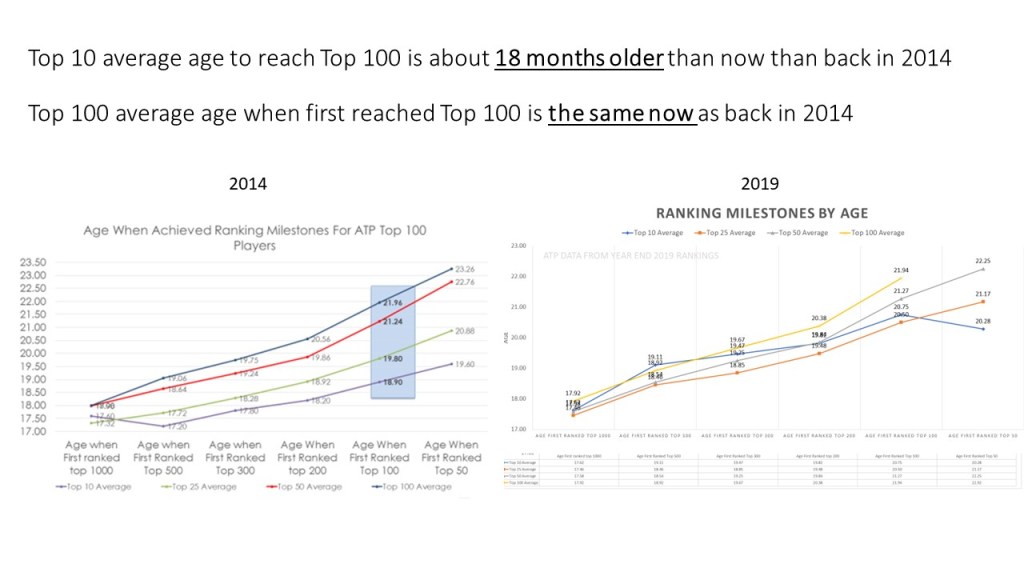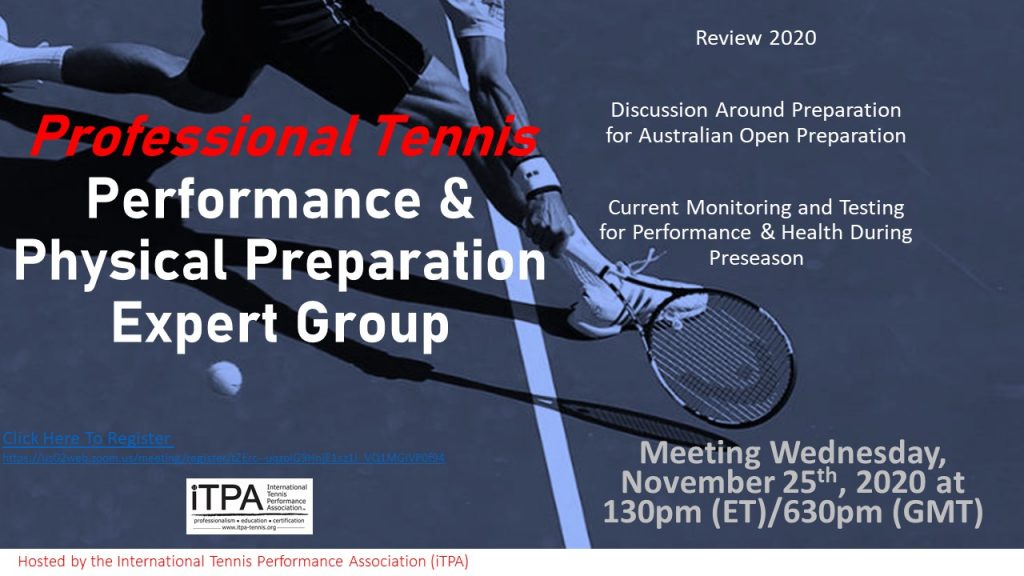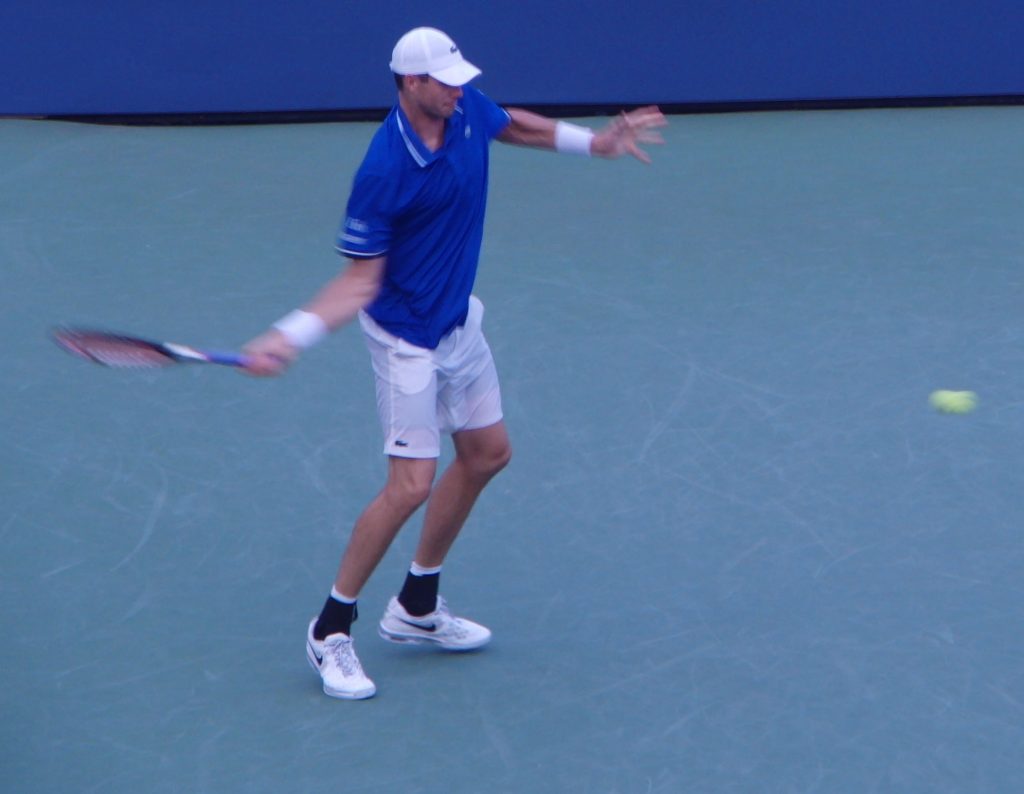MEMBER LOG IN
Categories
Links
Category Archives: General
Knowing The Ranking Pathway To Professional Tennis
By Mark Kovacs, PhD, CTPS, MTPS
If you work with high level juniors, collegiate players or young transitional professional players this article will be valuable. If the goal of these players is to make it to the Top 100 on the ATP or WTA tours they will need to progress through a few stages of development. Below is some real-world data that can help all iTPA professionals when working with these individuals.
Making it in professional tennis is usually discussed in the terms of making it inside the Top 100 in either the ATP or WTA rankings. This is a lofty goal and most professional tennis players do not actually make it inside the Top 100. Although many very good tennis players never make this ranking milestone, (and it is certainly a very high bar) it is somewhat similar to a player who makes the NBA G-League but never makes the NBA or a minor league baseball player who never makes the Majors. These athletes are some of the best in the world, but never reached the highest pinnacles of their respective sports.

For purposes of discussion, we will focus on individuals that do reach the Top 100 in the ATP and WTA rankings as it is usually the ranking that is used as a definition of success in pro tennis. The main reason is that this is the approximate cutoff for direct entry into the four Grand Slam (main draw) tournaments and also provides direct acceptance into many of the higher level professional tournaments. If an athlete can keep the ranking inside the Top 100 that usually means they can earn a good living playing tennis.
Over the past decade I have directed a number of research studies looking at what it takes for players to make the Top 100 ranking both from a qualitative and quantitative perspective. These studies have included data collection and analysis of thousands of hours of information with over one million data points. The original quantitative analysis was performed back in 2014 and it had very specific goals of determining what the best players did to achieve a Top 10, Top 25, Top 50 and Top 100 ranking. This included analysis all tournament results, matches played, rankings earned in junior tournaments, ITF events and pro events. This included looking at which athletes were on certain pathways and which players were not on certain pathways. Predictive analytics was used to help explain which athletes were tracking to certain ranking goals. This information has been used for many different purposes whether from a federation, coaching, agent, or player perspective when determining whether to go straight to professional tennis or to attend and compete at the collegiate level.
Although many variables exist in determining whether a player will achieve a certain tennis ranking, the data obtained from these studies highlight the rather consistent pathway that most players take to a Top 10 ranking. The Top 100 ranking has more variability, but it also provides a very consistent range that players fit in during their junior careers. Although every player has a different path to the Top, the data consistently shows that we really do not have major outliers in our sport. It requires a long journey and hitting a series of measurable benchmarks throughout the junior career, transition pro career and professional career.
Below are some of the major highlights of this data. This is a very small example of some of the data and provides a nice summary of certain aspects for both male and female tennis players.
If you prefer to watch and listen to a discussion of some of the major findings, please see this webinar that Dr. Mark Kovacs did.
Listen here to a 60 minute webinar on this topic where I discuss the data on the Functional Tennis Webinar


How Many Matches Do Players Play At The ITF Junior Level
Posted in General
Leave a comment
iTPA Professional Tennis Performance and Physical Preparation Expert Group
Here was our November meeting where over 50 Top physical trainers, CTPS professionals and top experts who train professional tennis players discussed the unique aspects of 2020 and also the preparation for the 2021 Australian Open and 2021 season.

Jez Green – Physical Preparation Coach for Andy Murray and Currently Alex Zverev
Satoshi Ochi – Head Strength & Conditioning Coach for the United States Tennis Association
Gabriel Echeverria – Physical Preparation Coach for Tennis Australia
Dozens of other top coaches working with professional players
Posted in General
Leave a comment
WTFC 2018 Presentation Video: Gil Reyes
This presentation video from the 2018 ITPA World Tennis Fitness Conference features Gil Reyes. Continue reading
Retraining Your Tennis Athletes After Quarantine (Recording of LIVE Discussion with ITPA Members)
This is a recording of a LIVE Zoom Discussion moderated by Mark Kovacs with over 40 top ITPA members (physical trainers, athletic trainers, physical therapists, tennis coaches and other healthcare providers). The main purpose was to discuss ramp-up strategies after the unusual period of de-training, and how to safely and effectively prepare tennis players for competition after an extended break.
Posted in General
Leave a comment
iTPA Member Only Online Zoom Discussion About Tennis Fitness During Covid-19
This zoom meeting was with some high level iTPA members discussing how they are currently working during the Covid-19 crisis. Some great ideas were shared and this is a great benefit of being an iTPA member to be able to network with so many great professionals.
Posted in Covid-19, General
Leave a comment
Training Your Core For Tennis
This is a great video from Dean Hollingworth, CTPS, MTPS. Dean is one of the best in the business and an ITPA Master Tennis Performance Specialist (MTPS). Here are some great exercises that are appropriate for tennis players to improve core strength, stability and endurance. This video was taken during the TENNIS CONGRESS. The iTPA is the official sport science and tennis fitness provider for this event and we have dozens of iTPA members on the faculty.
Why the Sudden Rash of Injuries in the top 10 Men’s Tennis?
By Patrick Aubone
For the first time in as long as I can remember a Grand Slam lacked star power on the men’s side. The list of casualties from the top 10 was pretty big: Andy Murray (hip), Novak Djokovic (elbow), Milos Raonic (wrist), Kei Nishikori (wrist), Stan Wawrinka (knee). Continue reading
Posted in General
Leave a comment
Long Term Athletic Development: Considerations Within Tennis, A Practical Approach Part 2
by Jonny Fraser, CTPS, MTPS
Owner of Science in Tennis, Strength and Conditioning Coach Claudio Pistolesi Enterprise
Long Term Athletic Development: Considerations Within Tennis – A Practical Approach Part Two.
The aim of this group of articles is to provide evidenced based practical considerations on how LTAD can be implemented within tennis clubs, regardless of facilities, number of players or coaches working in the program. Part one emphasised the importance of how motor skill and strength development should work alongside the delivery of tennis coaching. Continue reading
Posted in General
Leave a comment
What Exactly are you Training?
What Exactly are you training?
Maybe it’s me but it seems like YouTube and Facebook are packed with more and more fitness videos that are proving to be more circus oriented than quality driven. I truly feel sorry for parents, athletes and coaches who don’t have the background to properly analyze what they are watching. Continue reading

